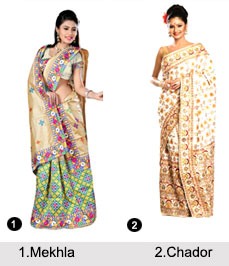 Sarees of North East India have a noticeable characteristic that are displayed in the wide array of sarees with distinct variations. The sarees of north-east India are a mixture of hill tribal textiles and fabrics that probably originated in eastern India.
Sarees of North East India have a noticeable characteristic that are displayed in the wide array of sarees with distinct variations. The sarees of north-east India are a mixture of hill tribal textiles and fabrics that probably originated in eastern India.
The North East region has a significant history of weaving and wearing full-length sarees, though saree is not hugely used among the inhabitants. The weaving technique and the variation of the sarees have increased the demand of different sarees in this region. A wider range of traditional supplementary colours are also used with motifs woven throughout the fabric including the borders of the North eastern sarees.
Fibres of North-East India
The natural fibres like Cotton, Muga, Tussar and Eri Silk are indigenous to the north east India. Of the 3 wild silks, Eri Silk is too heavy to be made into sarees and is usually woven into Chadors. However all 4 types of fibre are left with their natural colours of off-white and shades of pale brown hence the traditional sarees of Northeast India are not devoid of their natural sheen. Cottons are sometimes dyed in red or black to offer the desired colour to the sarees of this region. In many occasions, wild silk is usually left in its natural colour.
Designs of North-East India
Most weaving of the sarees of Northeast India occurs in villages and towns surrounding Guwahati, with Sualkuchi to the north specializing in silk, and Nagaon, further east, specializing in cotton-weaving. The sarees created here follow 2 distinct styles relating to tribal and mainstream pan-Indian. The sarees of Northeast India with tribal designs tend to be abstract and geometric with depictions of natural objects like flowers, leaves and animals in highly stylized forms.  The supplementary threads most commonly used in the sarees of Northeast India are red, black, purple, white, yellow, green and turquoise. The sarees of this region are intricately designed with kalga pattern. Round-petalled butis and life-like depictions of animals and plants are common in the patterning style of the sarees. Assam is the only area in South Asia where rhinoceros are woven into its sarees as decorative motifs.
The supplementary threads most commonly used in the sarees of Northeast India are red, black, purple, white, yellow, green and turquoise. The sarees of this region are intricately designed with kalga pattern. Round-petalled butis and life-like depictions of animals and plants are common in the patterning style of the sarees. Assam is the only area in South Asia where rhinoceros are woven into its sarees as decorative motifs.
Different Types of Saree in North-East India
In the sarees of Northeast India patterning is usually more elaborate. The textile and dress habits have more in common with those from China, South-East Asia and Tibet, although Bengali muslins had an impact on some upper-class textiles.
•Mekhla: Traditionally, full-body sarees are not worn here. The Assamese of Ahom origin wear a Lungi called a "Mekhla" and an upper wrap or shawl called "Chadar". The different tribal communities have different tradition of draping attires, sometimes they resemble with a saree and sometimes a different type of dressing style is seen.
•Moirangfee Sarees: The north east region of India is known for the Moirangfee Saree which is woven as a fine cotton fabric. This particular saree of Northeast India is similar to Nepali Dhaka cloth and Bengali Jamdani saree. This is the earliest textile that the valley tribe first wove and has probably originated in the eastern India. Red borders with either dark blue or white grounds are the traditional colours for these sarees.
•Muga Silk Sarees: The north east region is the centre where Muga Silk, Tussar and other type of silks are cultivated. The weavers and designers of this region create intricate patterns to make the sarees exceptional examples of north-east Indian creations. The geometric patterns woven into this saree are often associated with the Bodo and Garo tribes of western Assam and Meghalaya. The sarees are also hugely preferred and worn by the people of this region.
Tripura has the tradition of weaving this particular kind of sarees since the mid-1990s. The tribal communities of Manipur produce fabrics by loin loom. The sarees of north east region amidst their style, design, pattern and motif echoes the tradition and heritage of Northeast India.





















